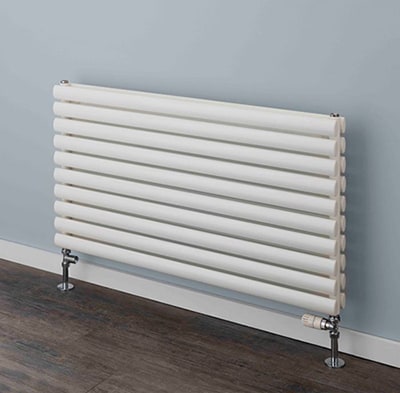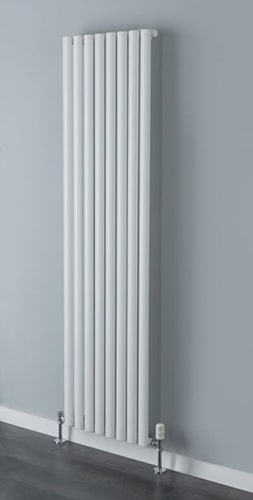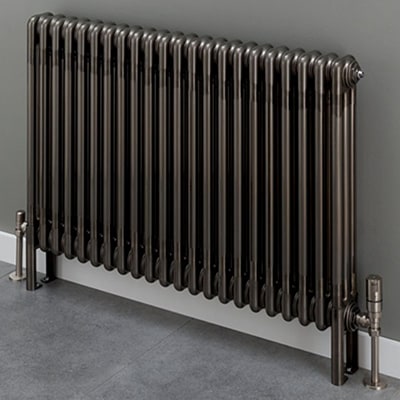Horizontal vs Vertical Radiators

Supplies 4 Heat Tallis Double Horizontal Radiator
If you are choosing radiators for your home, the choice can be overwhelming. Long gone are the days when your only option was a bog standard white horizontal panel on the wall. These days, radiators can come in all sorts of different shapes and sizes and some can look more like works of art than heat sources.
If you’re not in the market for a completely weird and wacky radiator, you can narrow things down a bit by choosing between a horizontal or a vertical radiator. Both have their advantages and disadvantages. Let’s look into them both in more detail.
Horizontal Radiators
The classic horizontal radiator has been around for years but that doesn’t mean that it has to be boring. If you have a traditional home, there are some beautiful, classic style horizontal radiators to choose from, for example, the Supplies 4 Heat Cornel 4 Column Horizontal Radiator Lacquer, which is a stunning twist on an original design.
But there are some great modern horizontal radiators too - if your décor is more about clean lines and minimalism, take a look at the Supplies 4 Heat Tallis Double Horizontal Radiator White, which would fit right in.
You could say that horizontal radiators take up valuable wall space and that a vertical radiator would enable you to use more wall space for furniture. This is partly true because, like for like, in terms of power, vertical radiators are a lot narrower than their horizontal counterparts.

Supplies 4 Heat Chaucer
Single Vertical Radiator
However, you could also argue that horizontal radiators are usually placed under a window, on an external wall as that is the coldest part of the room. If this is the case, it is unlikely that you could put much furniture in front of the window so, in this instance, you wouldn’t really be losing much usable wall space at all. Of course, it all comes down to where you would place the radiators in your space.
If you already have horizontal radiators and you are looking to upgrade them, it would be a lot simpler to just swap out the old horizontal radiators and replace them with new horizontal radiators, as long as they have similar dimensions.
This would mean that you wouldn’t have to take up flooring and floorboards to change pipework, making the whole job a lot quicker and less messy. A horizontal radiator is also useful to dry things on, although we don’t recommend doing this regularly because you could end up with condensation issues.
Vertical Radiators
Vertical radiators, as mentioned above, are definitely space savers. The use of the vertical wall space means that you will have more horizontal space that you could use for furniture, kitchen cabinets or anything else you need to fit into the room.
This is especially useful if you have a room with hardly any free wall space. You might think that you can only fit a small, less powerful radiator and resign yourself to the fact that the room will just have to be cooler.
But, if you invested in a vertical radiator, you could use the same amount of wall space as that small horizontal radiator and have a much more powerful radiator which spreads vertically up the wall instead. This would ensure that your room would be adequately heated.
You might have an external door that makes your space cold and perhaps there is only a small strip of wall to the side of it. Cue the vertical radiator! They can be ultra slim and tall, enabling you to heat even the smallest of spaces.

Supplies 4 Heat Cornel 4 Column Horizontal Radiator
As well as being space saving, the vertical radiator is effortlessly stylish. A room can be instantly transformed by adding a sleek vertical radiator to your wall. They are almost like works of art – in fact, some of them are. There’s no doubt that adding vertical radiators to your home makes a statement.
So, there you have it, horizontal versus vertical radiators. Really, it all comes down to how you want to use your space, the things you want to put in it and your style. Before you make your decision, there are a couple of things to bear in mind.
If you don’t already know, use an online calculator to calculate how powerful your radiator will need to be to adequately heat your room. You will be given a result in BTUs.
BTUs are British Thermal Units and they tell us how efficient radiators are. The higher the BTUs, the faster the radiator will heat your room. Look at the radiator’s specifications to make sure that it has either equal to or more BTU output than your calculator suggests.
If you are planning on swapping your radiators for larger ones or installing extra radiators to your home, be sure to check that your boiler can handle the added work.
Still not decided? Take a look at our fabulous range of radiators to help you with your decision.
